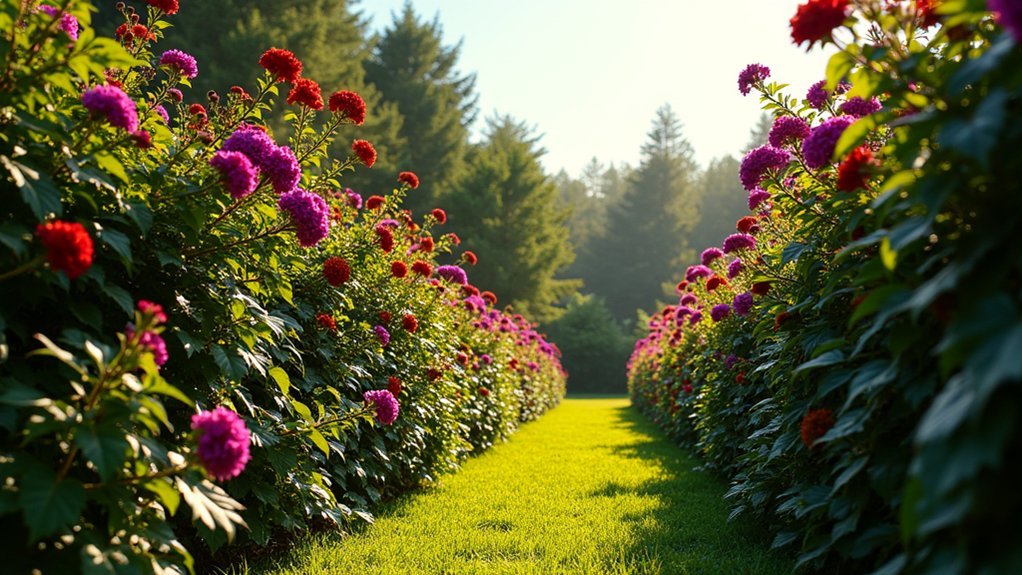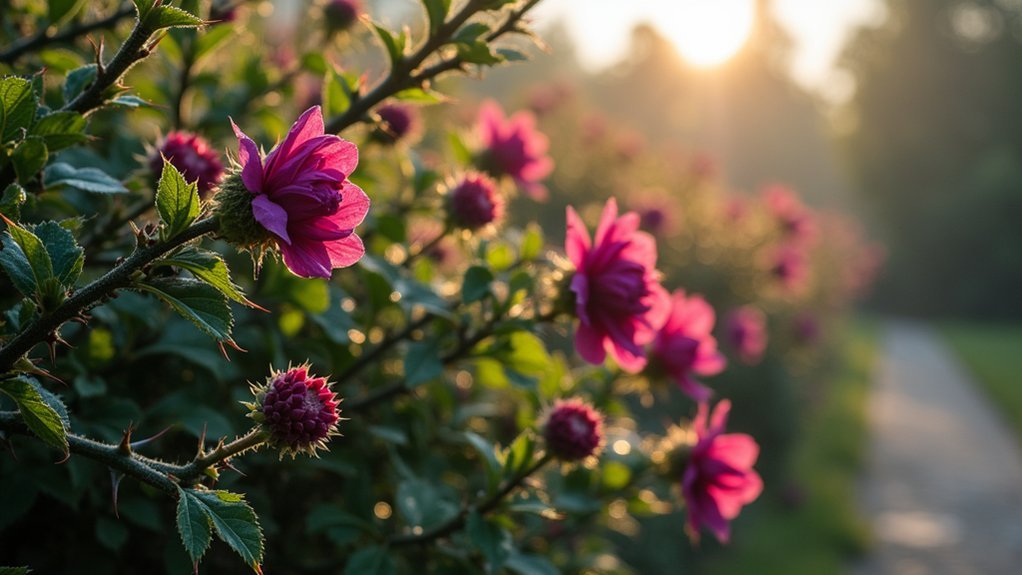Firethorn, barberry, and shrub roses create effective security barriers with their sharp thorns while offering beautiful blooms. Pyracantha features intricate thorns and vibrant berries, while blackthorn provides long sharp spikes with spring blossoms. Bougainvillea works well in warmer zones with its hooked thorns and colorful bracts. You’ll get maximum protection by combining species in layers, positioning taller plants behind shorter ones. Discover how these natural deterrents can transform your home’s defense while enhancing its beauty.
Top Thorny Flowering Hedge Options for Home Security

When considering natural security options for your property, thorny flowering hedges offer an attractive yet formidable barrier against unwanted visitors.
Firethorn creates impenetrable barriers with stiff thorns and grows up to 12 feet tall, producing white flowers and colorful berries.
Shrub roses feature dense curved thorns with fragrant blooms and resist deer damage.
Barberry’s needle-like spines accompany yellow flowers and require minimal pruning at 3-6 feet.
For taller barriers, blackthorn reaches 12-15 feet with long, sharp spikes and early spring white blossoms.
In warmer zones (9-11), bougainvillea’s hooked thorns and vibrant multi-colored bracts create a stunning 10-15 foot defense when supported. These plants require minimal maintenance while still providing effective security benefits.
Place these hedges strategically under windows or along fence lines for maximum security at lower long-term costs.
Beauty With Bite: Most Effective Flowering Deterrents
While security remains the primary function of thorny hedges, you needn’t sacrifice beauty for protection.
Pyracantha combines intricate thorns with vibrant berries, making it both a deterrent and wildlife haven. Plant this evergreen shrub in early spring for optimal establishment and years of security with its cream-colored summer blooms.
Blackthorn’s spectacular white blooms and formidable thorns create an impenetrable barrier with seasonal charm.
Hawthorn offers dense, thorny coverage alongside its flowers and fruits that attract birds.
For sharp spines and dense growth, choose Berberis, which forms secure boundaries while adding visual interest.
Gorse brings bright flowers to your security perimeter while ensuring intruders think twice.
Seasonal Considerations for Thorny Defensive Plantings

The strategic choice of winter-hardy thorny barriers like Firethorn guarantees your home remains protected even when temperatures plummet below freezing.
You’ll enjoy both enhanced security and visual appeal during summer months when flowering varieties like Rosa rugosa burst into bloom, creating a beautiful yet formidable boundary.
Regular seasonal pruning of your thorny hedges—especially after flowering periods—will maintain their density and effectiveness, closing potential gaps that might otherwise compromise your defensive perimeter.
For optimal perimeter security, consider planting thorny climbing plants on fences to discourage scaling attempts while enhancing your landscape design.
Winter-Hardy Barriers Remain Effective
During harsh winter months, thorny flowering hedges stand as vigilant guardians of your property, never taking a seasonal break from their protective duties. Unlike man-made barriers, these natural defenses maintain their effectiveness year-round.
Evergreen varieties like Holly and Pyracantha retain their dense foliage and sharp thorns throughout winter, creating continuous physical barriers. English Holly particularly excels here with its toxic red berries adding an additional deterrent while maintaining its impressive 15-foot height through the coldest months. Blackthorn’s resilience to cold temperatures and strong winds makes it ideal for exposed positions, while Berberis adds vibrant winter color without sacrificing security.
You’ll appreciate how these hedges require minimal winter maintenance once established. Their root systems stabilize during dormancy, preventing soil erosion even in freezing conditions.
Beyond security, they provide essential wildlife habitat when other resources are scarce, offering shelter and sustenance for birds that help control garden pests.
Summer Bloom Security Benefits
Summer transforms your thorny defensive hedges into spectacular security features that combine protection with aesthetic appeal. While maintaining their robust deterrent qualities, these plants burst into vibrant displays that enhance your property’s beauty.
| Plant Variety | Summer Security Benefit |
|---|---|
| Pyracantha | Bright flowers attract pollinators while thorns deter intruders |
| Rugosa Roses | Strong fragrance and dense thorny growth under windows |
| Berberis | Colorful foliage with impenetrable prickly barrier |
| Blackberry | Edible fruits alongside formidable thorny protection |
| Holly | Year-round sharp leaves with summer berries for wildlife |
You’ll find these summer-blooming varieties require minimal maintenance compared to traditional fencing while supporting local biodiversity. Their seasonal displays change throughout summer, ensuring your security barrier remains both functional and visually striking. These prickly options provide year-round protection while being more cost-effective than conventional fencing solutions. Consider combining different varieties for continuous protection and color.
Seasonal Pruning Enhances Protection
Strategic pruning throughout the year dramatically enhances both the protective qualities and overall health of your thorny defensive hedges.
Late winter pruning redirects energy to protective growth while allowing clear visibility of deadwood for removal. You’ll avoid disrupting nesting birds while seeing the structure clearly.
After flowering, summer maintenance preserves berries for wildlife while maintaining thorn density. This selective approach prevents hiding spots and encourages lateral branching for a denser barrier. These maintenance practices support plant companionship that contributes to the overall ecosystem health and resilience.
Follow the three-year rejuvenation method by removing ⅓ of oldest stems annually, and maintain the “three-ten rule” (3ft base height, 7ft+ limb clearance).
Always make 45° angle cuts to promote outward growth, and disinfect tools between plants.
Different species require specific timing—prune hawthorn February-March, rugosa roses after first bloom, and renew blackberry canes during dormancy.
Planting and Maintenance Tips for Security Hedges

Creating an effective security hedge requires thorough planning and diligent maintenance to guarantee it serves as both a physical deterrent and aesthetic boundary.
A well-designed security hedge blends robust protection with visual appeal through calculated planning and consistent care.
Prepare your site by clearing debris and testing soil pH to match your chosen thorny species’ needs. When planting, dig holes twice as wide as root balls and space plants strategically for ideal density without overcrowding.
- Water thoroughly after planting and apply organic mulch to retain moisture and suppress competing weeds.
- Prune annually to maintain density and eliminate potential entry gaps.
- Plant adjacent to existing barriers like fences to create layered protection.
- Position denser plantings at vulnerable entry points and property corners.
- Select evergreen varieties for year-round security with species adapted to your climate zone.
These security solutions offer a cost-effective alternative to traditional fencing while providing additional benefits like wildlife habitat and seasonal visual interest.
Combining Thorny Species for Maximum Protection
You’ll create a more formidable security barrier by combining multiple thorny species with different growth habits and protective features.
For maximum protection, plant taller species like holly or blackthorn behind lower-growing roses or barberry, ensuring defensive coverage at various heights while staggering plantings at 45° angles to walls for complete perimeter security.
Maintain this layered defense by regularly pruning to encourage dense growth, while allowing branches to interlock between species for seamless coverage with no weak points. Consider adding pyracantha to your defensive scheme, as its poisonous thorns make it particularly effective at deterring potential intruders.
Layered Defense Approach
When planning your garden security, a layered defense approach offers the most extensive protection against unwanted visitors.
You’ll create an impenetrable barrier by combining multiple thorny species with different growth habits and characteristics. This strategy not only enhances security but also creates visual interest in your landscape.
- Combine tall plants like blackthorn at the back with shorter species like holly in front
- Mix evergreen thorny plants with seasonal bloomers for year-round protection
- Position the most aggressive thorny species under windows and near fence corners
- Integrate climbing roses or firethorn along existing structures for additional coverage
- Consider how different species work together—dense foliage of one plant can complement the thorny structure of another
Installing a layer of gravel or pebbles around the perimeter of your tactical landscaping acts as a natural noise alarm when stepped on, further enhancing your home’s security.
Strategic Planting Tips
Strategic planning elevates thorny hedges from simple barriers to sophisticated security systems for your garden.
Combine hawthorn with holly for a dense, wildlife-friendly barrier that’s difficult to penetrate. For maximum effectiveness, mix climbing roses with brambles to create varied thorny textures that deter intruders.
Layer your defenses by planting species of different heights—taller thorny shrubs backed by lower, sprawling varieties prevent scaling attempts.
Position flowering thorny plants like pyracantha near windows and doors, while using robust species such as blackthorn along property perimeters. Maintaining clear sightlines around these defensive plants enhances their security value while allowing for better surveillance of your property.
Don’t forget climate considerations; choose drought-tolerant options like barberry in dry regions, while cold-hardy varieties such as rugosa roses work well in northern gardens.
This thoughtful combination approach guarantees year-round protection without sacrificing your garden’s visual appeal.
Maintenance For Density
Creating a formidable barrier requires combining complementary thorny species while maintaining consistent pruning schedules throughout the year.
You’ll need to trim regularly to promote dense growth where intruders can’t penetrate. Regular pruning is essential for developing healthy, uniform plants that create an effective barrier. Different species require specific care approaches, so coordinate your maintenance schedule carefully when mixing varieties like Pyracantha and Berberis.
- Prune 2-3 times annually to maintain shape and encourage lateral branching
- Apply species-appropriate fertilizers in spring to boost growth and density
- Layer shorter thorny plants in front of taller varieties for thorough protection
- Remove dead or diseased branches immediately to maintain barrier integrity
- Use the right tools (long-handled pruners, thick gloves) to protect yourself from thorns during maintenance
Wildlife Benefits of Defensive Flowering Hedges
Though often planted primarily for security, thorny flowering hedges serve as essential ecological lifelines in our landscapes.
You’ll create safe travel routes for mammals, birds, and insects while supporting thousands of species in a single hedge system.
Your defensive hedge provides year-round food sources—nectar-rich flowers attracting pollinators, berries feeding birds that control garden pests, and dense foliage sheltering small creatures from predators and harsh weather.
Beyond security, your thorny hedge becomes a living sanctuary—nurturing pollinators, feeding birds, and sheltering vulnerable wildlife throughout the seasons.
In urban settings, these living barriers reduce pollution while enabling wildlife to navigate developed areas.
Native hedge species specifically support 600 flowering plants and provide critical habitat for numerous insects, birds, and mammals that rely on these ecosystems.
They’re particularly valuable for protecting endangered species, with over 130 at-risk creatures relying on hedge ecosystems for survival.
Unlike artificial barriers, thorny hedges offer these benefits while requiring minimal maintenance, improving soil health, and naturally deterring unwanted visitors—making them a sustainable security solution with profound ecological value.
Frequently Asked Questions
Are Thorny Hedges Legal in Residential Neighborhoods?
Thorny hedges are generally legal in residential neighborhoods, but you’ll need to follow local regulations, height restrictions, and property line setbacks. Check with your HOA or local authorities before planting to avoid potential disputes.
How Long Until Thorny Hedges Become Effective Security Barriers?
You’ll see basic deterrence after 2-3 years, but thorny hedges become truly effective security barriers in 3-5 years, depending on species, soil quality, and maintenance. Pyracantha establishes fastest, while holly takes longest.
Can Children and Pets Safely Coexist With Thorny Hedges?
Yes, children and pets can safely coexist with thorny hedges when you choose non-toxic varieties like boxwood or juniper, strategically place them away from play areas, and supervise outdoor activities to prevent injuries.
Do Thorny Hedges Damage Neighboring Property Foundations?
Thorny hedges can damage neighboring foundations if you plant large varieties with aggressive roots too close to structures. Their roots seek moisture, disrupt soil stability, and their thorns may physically scratch exterior surfaces over time.
Will Thorny Hedges Interfere With Home Insurance Coverage?
Thorny hedges won’t typically interfere with your home insurance, but you’ll need to maintain them properly. Overgrown hedges could create liability issues if someone’s injured or they damage covered structures on your property.
In Summary
By planting thorny flowering hedges, you’ll create an attractive security barrier that serves multiple purposes. You’ve now discovered options that balance beauty with protection, understand seasonal considerations, and know how to maintain these living defenses. Don’t forget that combining several species creates the most effective barrier. As a bonus, you’re providing valuable wildlife habitat while keeping intruders at bay—a truly smart landscape investment.





Leave a Reply